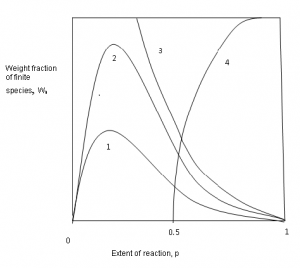This set of Polymer Engineering Multiple Choice Questions & Answers (MCQs) focuses on “Prediction of Gel Points”.
1. How does the viscosity vary with the onset of gelation of reaction mixture?
a) increases
b) decreases
c) remains constant
d) none of the mentioned
View Answer
Explanation: With the onset of gelation, the medium viscosity increases rapidly and formation of insoluble mass (gel) takes place.
2. The cross linking established by linking the branched units leads to three dimensional structure which gives rise to the phenomenon of gelation of reaction mixture. State true or false.
a) true
b) false
View Answer
Explanation: The cross linking of branched units lead to the formation of measurable proportion of insoluble and infusible mass called gel, which then rapidly gets transformed into visco-elastic mass, if reaction continues beyond the gel point.
3. What does f in the expression for critical probability that the branched unit is linked to another branched unit, represents?
a) average functionality
b) functionality of branched units
c) functionality of monomer
d) none of the mentioned
View Answer
Explanation: The expression for critical probability is given by,
αc = 1/(f-1)
The f, here represents the functionality of branched units and if more than one branched units differing in functionality are used, then f is the average value of all multi-functional monomers.
4. What is the critical value of probability for trifunctional branch unit?
a) 1
b) 0.5
c) 0.25
d) 0.7
View Answer
Explanation: The critical probability for a trifunctional branch unit is 0.5 and it can be verified using the formula
αc = 1/(f-1).
5. Which of the following assumptions fail taking into account the example of glycerol?
a) equal reactivity of functional groups
b) intramolecular cyclization reactions are forbidden
c) all of the mentioned
d) none of the mentioned
View Answer
Explanation: Glycerol contains three hydroxyl groups where secondary hydroxyl is less reactive than other two primary hydroxyl groups. This violates the assumption of equal reactivity.
6. The Carothers’ equation is used to predict the extent of polycondensation reaction at which the average degree of polymerization Xn, becomes infinite. State true or false.
a) True
b) False
View Answer
Explanation: W.H. Carothers derived a general expression, relating the average functionality, extent of reaction and degree of polymerization, which is known as Carothers’ equation
p= (2/f)(1-1/ Xn).
7. Why is it advisable to stop the reaction nearly 10-15% earlier the critical reaction completion?
a) cross-linking occurs
b) to avoid damage of reaction bowl
c) insoluble, bad quality product is obtained
d) all of the mentioned
View Answer
Explanation: If the reaction continues beyond the critical point, the product obtained will be unusable. So, it is advised to stop the reaction 10-15% earlier in p to avoid all the above problems and get good quality product.
8. Which curve represents the gel formation in the following graph, for a trifunctional polycondensation

a) 1
b) 2
c) 3
d) 4
View Answer
Explanation: For a trifunctional system, gelation start at p=0.5, and at p=1, the whole system is converted into insoluble and infusible mass of a giant molecule. So curve 4 represents the gelation process.
Sanfoundry Global Education & Learning Series – Polymer Engineering.
To practice all areas of Polymer Engineering, here is complete set of 1000+ Multiple Choice Questions and Answers.
If you find a mistake in question / option / answer, kindly take a screenshot and email to [email protected]
- Check Chemical Engineering Books
- Check Polymer Technology Books
- Apply for Chemical Engineering Internship
- Practice Chemical Engineering MCQs
